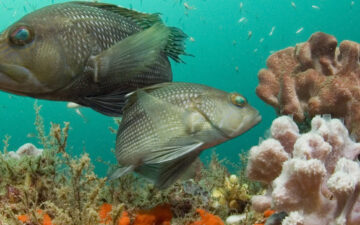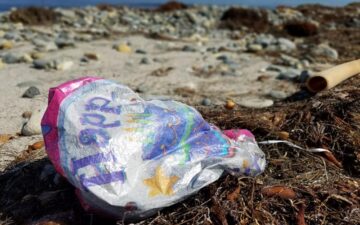by Kenneth Stump, Ocean Policy Fellow at The Ocean Foundation

Forage Fish (School of Goldband Fusilier, Pterocaesio chrysozona. Papua New Guinea – Source: Wikimedia Commons)
As much as a third of the global annual catch of wild fish, totaling tens of billions of pounds of fish every year, consists of small to medium-sized forage fish that serve as prey for other fish, seabirds and marine mammals. Much of this catch is not destined for direct human consumption but instead is processed into fishmeal and oil for use in a variety of livestock and poultry feeds, pets foods, fish oil supplements and, increasingly, as the base of feedstock for farmed fish such as Atlantic salmon and crustaceans such as shrimp.
The Lenfest Ocean Program, a project of the Pew Charitable Trusts, commissioned a Forage Fish Task Force to assess the impacts of these industrial-scale fisheries on competing marine predators and ocean food webs. The report, “Little Fish, Big Impact,”[1]finds that these fish generally have far greater monetary value if left in the water to feed larger, more valuable food and game fish (cod, haddock, flounder, tuna, salmon, striped bass, bluefish, marlin, etc.) than as industrial fodder for livestock and farmed salmon. The Task Force’s key recommendation to prevent the decline of dependent predators (fish, marine mammals, seabirds) is to leave more prey in the water by reducing fishing on these key forage fish to half the conventional level that fishery managers typically aim for to achieve maximum sustainable yield (MSY) for the fishery.
The Lenfest report is a welcome addition to the growing body of research that highlights the threat posed by these massive fisheries to the ocean food web and the need for a more conservative management approach. Its recommendations validate and lend support to the ongoing efforts of many conservationists and recreational fishermen to reduce fishing on key forage species in U.S. waters, such as Atlantic menhaden and herring and Pacific sardines. Similar scientific findings and recommendations were published last year in research funded by the Marine Stewardship Council (MSC), the London-based sustainable seafood certification group.[2]
For all of its good points, however, the Lenfest Forage Fish Task Force report, like the MSC-sponsored research that preceded it, suffers from an overly narrow definition of forage fish. The Lenfest definition includes only a subset of small, silvery “baitfish” (e.g., anchoveta, sardine, menhaden, capelin, sand eel), which leaves out squids and other linchpin prey species such as Alaska pollock, hakes and mackerels, all of which are targets of some of the largest fisheries in the world. The North Pacific pollock fishery (U.S. and Russian combined) is the largest food fish fishery in the world, second only to the South American anchoveta reduction fishery in size. The direct and indirect competitive effects of the fishery on the prey availability have been implicated in the decades-long declines of competing pollock predators such as endangered Steller sea lions and depleted northern fur seals off Alaska’s southwest coast, among others.
 The exclusive focus on a subset of small, silvery finfish that fit the Task Force’s definition does not diminish the importance of its recommendations for a more conservative approach to forage fish fisheries generally in order to prevent the decline of top predators, but it highlights the need to identify key forage fish on an ecosystem-by-ecosystem basis. Otherwise there will be a strong temptation for fishery managers to limit the discussion of forage fish to a select subset of species while conveniently ignoring the food web impacts of some of the largest fisheries in the world. That is the case of the decline northern fur seal off Alaska right now, where steadily declining fur seal pup production appears related to declining prey availability and stands in sharp contrast to the fortunes of the pollock fishery over the same period (See figure above).
The exclusive focus on a subset of small, silvery finfish that fit the Task Force’s definition does not diminish the importance of its recommendations for a more conservative approach to forage fish fisheries generally in order to prevent the decline of top predators, but it highlights the need to identify key forage fish on an ecosystem-by-ecosystem basis. Otherwise there will be a strong temptation for fishery managers to limit the discussion of forage fish to a select subset of species while conveniently ignoring the food web impacts of some of the largest fisheries in the world. That is the case of the decline northern fur seal off Alaska right now, where steadily declining fur seal pup production appears related to declining prey availability and stands in sharp contrast to the fortunes of the pollock fishery over the same period (See figure above).
Conventional fishery policies fail to account for the critical role of forage fish as food for marine mammals, seabirds and commercially important fish such as tunas, salmon and cod. Leaving more prey fish in the water is critical to protect the ocean food web and the Lenfest report outlines a management strategy for doing so that makes good economic as well as ecological sense.
[1] Available at: http://www.lenfestocean.org/foragefish.
[2] Anthony D.M. Smith et al. (2011), Impacts of Low-Trophic Level Species on Marine Ecosystems, Science Vol. 333: 1147-1150.







